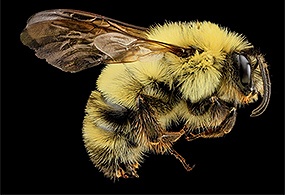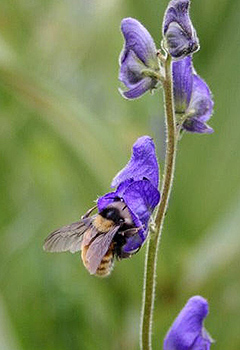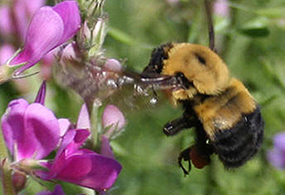By giving off good vibrations, bumble bees change the world one plant at a time.
Agitators of the Insect World

Sam Droege, USGS
By giving off good vibrations, bumble bees change the world one plant at a time! Some fruits and vegetables need considerable agitation to release pollen. Bumble bees accomplish this by fastening their jaws to the plant and moving their flight muscles vigorously. This movement makes the familiar buzzing sound we associate with bumblebees and causes pollen grains to be released from the flower’s stamen.
Greenhouse growers used to rely on manual pollination, a time consuming, labor intensive process. Historically, bumblebees were often largely overlooked because they don’t produce large amounts of honey or live in large, portable colonies. With the discovery of their ability for “buzz pollination” (or sonication), however, bumblebee popularity is on the rise and there is a huge growth of bumble bee pollination in greenhouses.
Bumbling and Buzzing

USDA
There are approximately 46 species of bumble bees (genus Bombus) native to North America and 250 species worldwide—all dependent on flowering plants. Bumblebees rear their young with nutritious and protein-rich pollen, while the high sugar content of the plants’ nectar provides the bees with both food and energy. Diverse species have different lengths of tongues, which allow them to use flowers of various shapes and sizes.
The flash of color and the sound of a bee’s low buzz evoke memories of warm summer days and the scent of flowers. In addition to their sensory contributions, bees pollinate such crops as sunflowers, cotton, pumpkins, watermelon, peppers, tomatoes, clover, apples, citrus fruits, peaches, lima beans, mustard, many berries and more.
Long Live the Queen

USDA
Most types of bumblebees nest in dry and dark underground colonies, shared by 50 to 400 bees. A few bumblebee species nest above ground, finding homes in such places as hay stacks, tree cavities, thick grasses and other hideouts. Emerging from an overwintering site, a lone queen seeks out a suitable site to begin a new colony. Once found, she collects pollen and lays her first brood of eggs, consisting of all female “worker” bees. In turn, the newly hatched assistants collect pollen and nectar to rear the next brood of their queen. Some of the workers ensure the protection and cleanliness of the nest, while others are on “nursery detail,” tending the young and newly laid eggs.
New queens and males are produced in late summer. Once mated, a new queen immediately prepares for hibernation by gorging herself on pollen and nectar. She then leaves the nest and spends the long winter months in a new underground retreat. The queens are the only ones to survive the winter.
Lost Colonies
Bumblebee numbers are declining. Several of the leading causes include:
- Habitat loss and fragmentation
There are less open, undisturbed spaces, leading to a shortage of flowers. Bumblebees depend almost entirely on flowers for their food. - Pesticides
Pesticides used during the spring especially affect bumblebees because the populations of their colonies are still low. Species that nest above ground are also vulnerable to the negative impacts of systemic pesticides. - Diseases
New diseases are harming populations, as they are rapidly passed from one bumblebee to the next within the colony or via the flowers the bumblebees feed upon.
Bumblebees and the National Parks

Citizens, staff, and researchers at Acadia National Park have identified the native and non-native bees found within park boundaries.
North America has more than 4,000 species of native bees. Much of this diversity occurs in national parks, but many parks know very little about their bees. To help fill this knowledge gap, at least 50 national parks across the country have been inventorying native bees in habitats vulnerable to climate change. Some projects have focused specifically on bumble bees, working to identify and survey, and also comparing current and historical contributions of these pollinators.
Last updated: February 13, 2015
